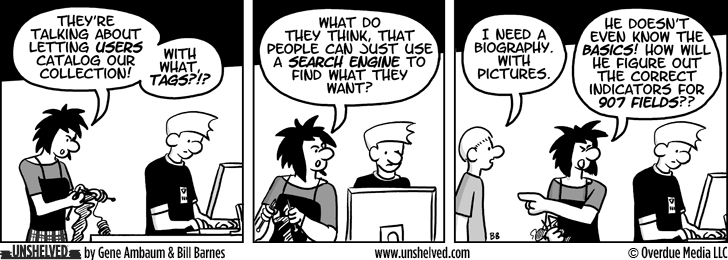The Cataloger- Rough Draft
Hello! Below is the rough draft. Somethings I hope to update/change 1) Make the Cataloger Game fun, maybe with more tests or images, 2) play with the data viz, 3) Work on relating the data viz/analysis with the literature/argument.
My overall argument is while there is a push in museums to include social tagging for visitors to add tags and museums to include more contextual information, we see this on primarily on social media platforms. This metadata created by social tagging and other crowdsourcing outlets should be included in digital collection catalog records. I think the idea is somewhere below, as of right now it’s a lot of word vomit and data viz. Thanks and enjoy the game!
Rough Draft
The Cataloger Game is ready when you are! Try to have fun, unlike this cataloger.

What made this game hard or easy? Was there enough information in each question for you to get the correct answer? Do you understand what a catalog record is?
The cartoon above by Unshelved, is a pretty good example of what museums and libraries are experimenting with, allowing users to add information to already existing catalog records.
Catalog Records and Digital Collections
With the rise in digital collections making museum objects available online, museum goers can stay home and browse through entire museum collections in a matter of seconds. Museum no longer rely solely on static exhibits open for a few months or a few years at a time. With entire collections available online, museums are creating more digital exhibits, webpages, and adding more interactive technologies, like augmented reality, into traditional exhibits. When an object is available online, metadata (or information about the item) is included for researchers. By doing so, not only can researchers use correct terms, photos of the object, and citation but museums are also vulnerable to how little metadata is given about objects. Let’s look at University of Pennsylvania Museum of Archaeology and Anthropology digital collection. Not only is the museum’s entire collection available online but so is all the metadata about those objects.
As you noticed in The Cataloger, the names of objects are vague. For example, only looking at the photo of the first object most people would consider that a string or maybe a shoelace. However, the catalog record states the object is a band. Why didn’t the cataloger use the term waist band or catalog this piece with the rest of the girl’s costume? Unfortunately, we cannot ask the cataloger why they did not give the object a more specific name. However, museum scholars like Hannah Turner, Benjamin Filene, and James Gardner note how past museum theories and practices do not fit in our digital lives.
The Literature
Cataloger’s are painfully aware of “legacy data”, a term used by Turner to describe metadata that was directly migrated to computerized systems from typed and handwritten records with no attention to accuracy.
Is this a hat? In Gardner’s article, he encourages museum professions to give some authority to visitor in museum exhibits by being transparent about museum practice and theory. The same should be applied to digital collections. Take this hat for example. When I look up the word hat in the catalog, this item shows up immediately. However when I search basket, this hat is still on the list of potential items. Looking at the hat it does resemble as basket. This may be an issue with the digital collection platform. Yet, it still begs the question, was this object once considered a basket then changed to a hat? If UPenn was transparent about any changes or even how objects are categorized (even an explanation on how objects are named or more provenance of an object) may better explain why this object is a hat.
Another part of The Cataloger was matching descriptions with objects. While that is not typically the case for museum catalogers, in most cases they either create their own description, use information available upon object’s arrival to the museum, or they will provide the most basic descriptions as possible. As you noticed in the game, these descriptions vary from extremely detailed, like the Huipil blouse to basic details like the human figure. Many museums are looking to expand descriptions by providing crowdsourcing opportunities to researchers and museum visitors.
Flickr is a popular platform for museums to allow social tagging and provide more contextual information. https://www.flickr.com/photos/pennmuseum/3614369530/ compared to the catalog record in the digital collection https://www.penn.museum/collections/object/463867
References
Turner, Hannah, “The Computerization of Material Culture Catalogues: Objects and Infrastructure in the Smithsonian Institution’s Department of Anthropology” Museum Anthropology 39 no. 2 (2016): 163-177.
Filene, Benjamin, “Passionate Histories: “Outsider” History-Makers and What They Teach Us” The Public Historian 34, no. 1 (2013) 11-33.
Gardner, James B., “Contested Terrain: History, Museums, and the Public” The Public Historian 26, no. 4 (2004) 11-21.